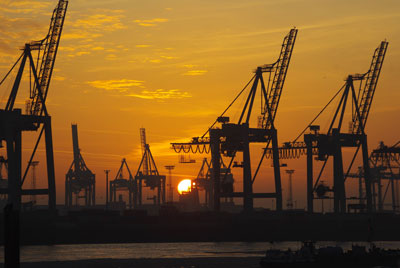
It sounds like a scene from 24: A terrorist group gets a hold of a nuclear bomb, places it in a cargo container, watches it being loaded on a tanker vessel, and waits for it to make the journey across the Atlantic to the U.S. It may arrive in any number of U.S. ports—say New York, New Orleans, or Baltimore. When it reaches its destination, someone gives the signal. Bam!—the U.S. is sent into a state of panic.
It may sound a bit far-fetched, probably because it is. Why would terrorists obtain a nuclear weapon only to let it out of their hands, to simply cross their fingers and hope it reaches its destination without being damaged or intercepted? Not only that, but most experts agree that a port is much more likely to be attacked by land than by sea.
Yet despite its implausibility, it’s exactly this type of scenario that has driven U.S. maritime security policy over the past several years.
Since, 2007 the Department of Homeland Security (DHS) has been under a mandate by Congress to scan 100 percent of U.S. bound maritime cargo by July 2012. In other words, Congress has required that each of the approximately 11.6 million maritime cargo security containers entering U.S. ports each year must be physically scanned.
Last July, a year out from the mandate’s implementation date, DHS made it clear that the 100 percent scanning mandate would not be met, a sentiment that was mirrored just this week in a hearing before the House Homeland Security Committee.
DHS Assistant Secretary for Policy David Heyman ultimately proclaimed that DHS is “continuing to operate under the law.” Yet he also explained that DHS currently scans only about 5 percent of inbound cargo due to restrictions in foreign cooperation and port capacity.
Instead, DHS has turned to a risk-based approach to maritime cargo security. And, as Customs and Border Protection (CBP) Acting Assistant Commissioner Kevin McAleenan explained, in fiscal year 2011, CBP scanned 96 percent of high-risk cargo. In doing so, they have never discovered an explosive or nuclear device.
While some were quick to criticize the remaining 4 percent that was left unscanned, DHS should instead be applauded for taking a step in the right direction. Scanning 100 percent of cargo does little more than give the illusion of 100 percent security. The reality is that no scanning system will ever be perfect.
Rather than taking a blanket approach to cargo security, using a risk-based approach allows DHS to analyze cargo attributes, such as contents and origin of the cargo container, to single out high-risk cargo for further inspection.
Kudos to DHS for recognizing the realities of the maritime supply chain. Now if only Congress would follow suit.


























